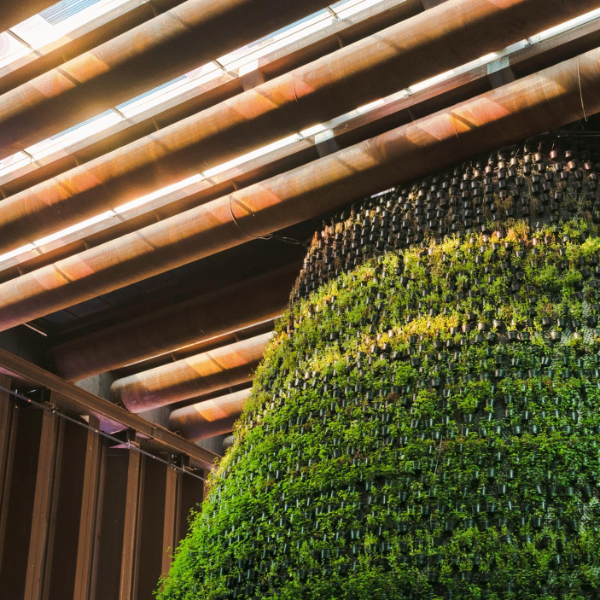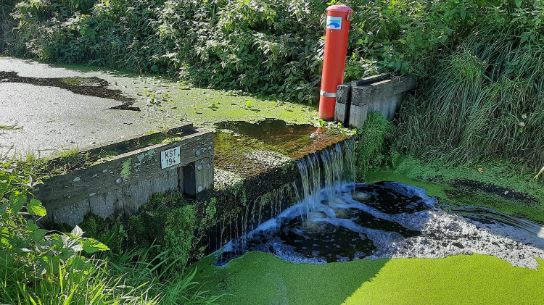Expo 2020 Dubai
Witteveen+Bos designs reusable Netherlands pavilion
Client
Ministry of Foreign Affairs / Netherlands Enterprise Agency
Location
Dubai, United Arab Emirates
Assignment awarded
2018
Completed
2021
Gross floor area
3,727 m²
Architect
V8 Architects
Pavilion construction and main contractor
Expomobilia
Interactive visitor experiences
Kossmanndejong
Sustainable aspects and structural design
Witteveen+Bos

Client
Ministry of Foreign Affairs / Netherlands Enterprise Agency
Location
Dubai, United Arab Emirates
Assignment awarded
2018
Completed
2021
Gross floor area
3,727 m²
Architect
V8 Architects
Pavilion construction and main contractor
Expomobilia
Interactive visitor experiences
Kossmanndejong
Sustainable aspects and structural design
Witteveen+Bos
Expo 2020 Dubai
A design for an attractive and intriguing circular building with innovative indoor climate systems, using Dutch innovations. That is what Witteveen+Bos delivered with the Netherlands Pavilion for Expo 2020 in Dubai. We were responsible for the structural design and the indoor climate system. Witteveen+Bos also worked on the building physics and the sustainable aspects of the pavilion. All building materials used are reusable, recyclable or biodegradable. This has now been put into practice.
We are proud that our innovative work was recognised at the Big 5 Impact Awards, where we received the award for Sustainable Construction Project of the Year. A consortium consisting of Expomobilia, V8 Architects, Kossmann.dejong and Witteveen+Bos was selected to design and construct the Netherlands Pavilion at Expo 2020 in Dubai.
If you are curious and interested in having a look at our exceptional pavilion, take the 3D tour below.
Uniting water, energy and food
The Netherlands Pavilion is designed as a biotope; a circular climate system that brings together innovative Dutch solutions uniting water, energy and food. The temporary circular climate system works by extracting water from the air and energy from the sun, allowing approximately 9,300 edible plants – such as tomato, basil, mint and asparagus – to grow.

Sustainable solutions
The pavilion is remarkable for being fully sustainable and was built using locally sourced materials that are reusable, recyclable or biodegradable. Witteveen+Bos worked on the pavilion’s sustainable aspects, which are an integral part of the experience. The pavilion’s design allows for a large number of visitors – high attendance figures are expected every hour – while also meeting the technical requirements for the indoor climate system to function effectively. As the building will only be in use for six months, the pavilion was designed with circularity in mind.
Maarten Veerman, project manager at Witteveen+Bos for the Netherlands Pavilion: ‘The pavilion was designed with circularity in mind. This is reflected in the choice of materials used for all components, including structural elements. Our team worked with a structure of steel sheet piles and steel tubes, as those materials are widely available and known for their reusability. Sheet piles are often used in temporary structures and many companies rent them out, contributing to the project’s fully sustainable nature.’
The box-shaped steel structure consists of two cofferdams – constructed using two rows of sheet piles – horizontally supported by a roof of steel pipes. The main level of the pavilion is 4.2 m underground, and the soil that was excavated to reach this depth was placed between the cofferdam walls. This created a stable structure capable of bearing all possible loads during its lifetime, including earthquakes.
The soil inside the cofferdams also creates good insulation and thermal mass, which is needed to maintain a comfortable temperature inside the pavilion. Although the Expo takes place during the cooler months in Dubai, temperatures in October and March can still reach 40 degrees Celsius.
Climate system
At the centre of the pavilion is an 18-metre-high cone-like structure, named ‘The Food Cone’. Its exterior is covered with a variety of edible plants, while oyster mushrooms cover its inside. These fungi are an important part of the biotope, emitting carbon dioxide which is absorbed by the plants on the cone’s exterior. The floor and wall panels are made from mycelium, a biodegradable fungus-based substance, demonstrating how mushrooms can be used within building materials.
The cone is not only the centrepiece of the pavilion; it is also the heart of the indoor climate system. Cool air flows into the cone, moving on into the main entrance hall at the end of the pavilion, which results in a cool indoor climate system throughout the whole structure. The choice of systems used to create the climate was also made with circularity and reuse in mind: all the main components were rented for the relevant period and will be returned at the end of the Expo.
An example of one of these systems is the adiabatic cooling system, designed by Witteveen+Bos. The air is cooled by the evaporation of water sprayed into the area through small nozzles. As the main engineers of the climate system for the Netherlands Pavilion, Witteveen+Bos is proud to have been able to integrate Dutch innovations – such as the rainmaker and the solar panels – into the overall systems design. This integration makes the design a truly collaborative effort.
Plants and panels
The pavilion’s roof consists of solar panels which illuminate and power the biotope. The vibrantly coloured panels were specially designed for the pavilion and are made from lightweight organic transparent solar cells (OPV), which are circular and constructed from non-toxic materials. These unique solar panels collect energy from the Dubai sun to power the pavilion while also allowing tinted daylight to enter the pavilion, filtering the right spectrum of light for the edible plants to utilise for photosynthesis. By these means, sufficient energy is gathered to supply all of the pavilion’s climate systems.
The Netherlands pavilion was on display from 1 October 2021 to 31 March 2022 in the so-called ‘Sustainability District’ of Expo 2020; a meeting place for business, educational and research institutions, and government and civil society organisations. After this Expo, the sustainable dismantling of the Netherlands pavilion was put into practice.
Reuse and recycle
The sheet piles and steel tubes used for the construction of the pavilion will be taken back to Meever and Meever, a Dutch company that specialises in civil structures in the UAE. The sheet piles and steel tubes, which reach up to 18 meters long, will be used for new construction projects in the UAE. Since the Netherlands Pavilion is built without the use of any concrete – not even for the foundations – the plot will be left as it was originally found in 2018, as a natural and empty piece of desert land. In 2018, desert sand was extracted from the excavation plot and used for filling the double sheet piles, whilst also serving as a temporary insulation material. The sand will be used to fill the plot again after the dismantling is complete. Inflatable ETFE material was used on the façade of the pavilion, which will be sent back to Taiyo in the UAE for partial reuse and recycling. The steel cables of the minimised rear structure of the façade will also be reused.
The floor of the Netherlands Pavilion is made from local sand and gravel from the desert. The prefabricated pavement mats were rented to stabilise the floor; by simply lifting these elements, the floor can be dismantled. The mats will all be returned to their supplier and used for new temporary pavements in Dubai.

Mushroom nursery
The white silos at the lounge of the Netherlands Pavilion contain the mushroom nursery and were specially designed using local standard pipes. The pipes have been kept intact and can be easily dismantled; they will be given back to the local building industry to be used in the future. The mushroom nursery will be taken over by a local entrepreneur in Dubai that will continue the production of mushrooms and mycelium products. By doing so, valuable knowledge is shared, and it facilitates the process of creating a biobased future.
The green cone
The 9,300 partly edible plants and herbs covering the central green cone inside the pavilion will be returned to the local supplier and turned into compost. The compost will serve as food for other plants. Likewise, the mycelium panels used for the walls inside the vertical farm and on the floor of the business lounge will be made into compost and returned back to nature. The irrigation systems used for the construction of the vertical farm within the Netherlands Pavilion will be dismantled and reused for a local greenhouse. Due to the construction of the cone-shaped vertical farm, the long lengths of hose can be reused effectively. The waterproof films and lead replacements will be taken back to Leadax for full recycling.
Water-making machine
The SunGlacier water-making machine, which was used for the climate system in the pavilion, is now proven technology to harvest water from the air. Engineered to fit inside a shipping container, the water maker will be shipped to the Netherlands. There, the technology will be further optimised for a new project to create water from air. The biobased curtains and canopy from Buro Belen are made from corn starch that was turned into biopolymer textile fibres and coloured with the oxides of the steel structure. Various options are being explored for the curtains to be exhibited in Dubai or to be shown at the Floriade in Almere, the Netherlands, for the agricultural world expo. Lastly, the solar panels on the roof of the pavilion were installed to provide the pavilion with renewable energy. The first batch of PV panels were rented locally and are now being installed elsewhere in the UAE. The second batch are specially designed organic, transparent PV foils created by Marjan van Aubel Studio. Talks with various parties are underway to explore the possibilities for a new application of the organic solar panels.
3D tour
At the end of March 2022, Expo 2020 Dubai closed. The Netherlands Pavilion was dismantled at this time. Fortunately, the pavilion and its visitor experience were captured on film – see, for example, this video.
More information?


Our projects
Every year we work on almost 5,000 projects on water, infrastructure, environment and construction.




